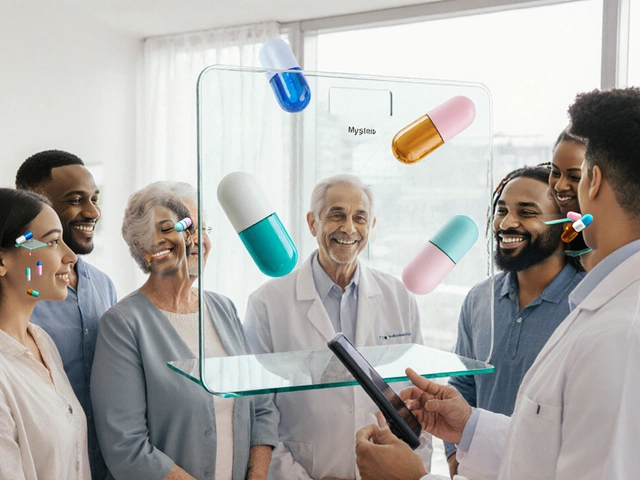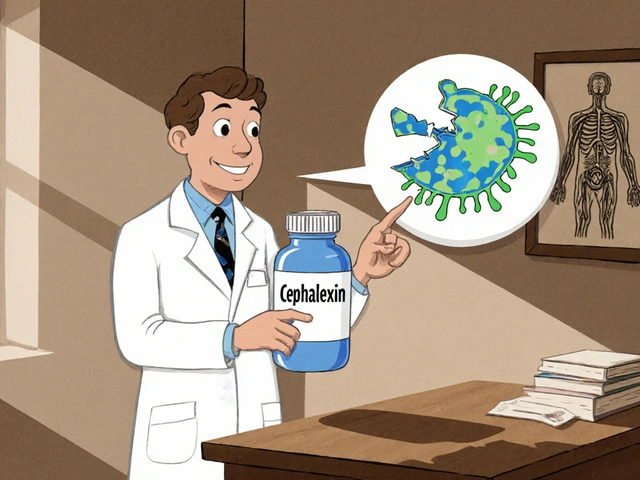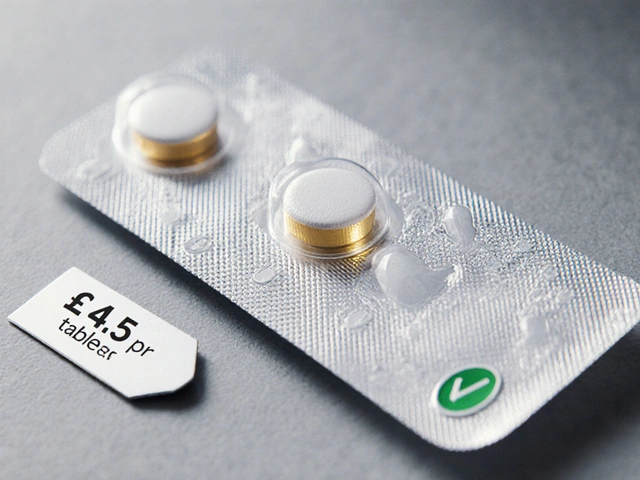Medication Organization Recommender
Find the best medication organization system for your specific situation. Answer a few quick questions to get personalized recommendations based on your medications, tech comfort level, and lifestyle.
Your Medication Organization Profile
Recommended System
Why this system works for you:
Tips for success:
Missing a pill. Taking two by accident. Forgetting if you already took your blood pressure medicine today. These aren’t just inconveniences-they’re risks. About half of people with chronic conditions don’t take their meds as prescribed, and medication errors contribute to around 7,000 deaths each year in the U.S. alone. The good news? You don’t have to guess your way through a medicine cabinet. Organizing your medications isn’t about fancy gadgets-it’s about building a system that works for you.
Start Simple: The Classic Pill Organizer
If you’re just beginning, a basic 7-day pill organizer is your best first step. These are the plastic boxes with compartments labeled Morning, Noon, Evening, and Bedtime. They cost between $3 and $25. No batteries. No apps. Just you, your pills, and a little planning.Here’s how to make it work: Every Sunday, sit down with your prescriptions and fill each compartment. Use a permanent marker to write the name of each pill on the lid if the label is too small. Keep the organizer in the same spot-on your nightstand, next to your coffee maker, or by the toothbrush. Consistency builds habit.
Studies show people using basic organizers improve adherence to about 62%. That’s better than nothing, but it’s not foolproof. You still have to remember to fill it. You still have to remember to take your pills. And if you miss a dose, no one knows but you.
When Things Get Complicated: Digital Pill Dispensers
If you’re on five or more medications, take pills at different times of day, or have memory issues, a digital dispenser might be worth the investment. The MedaCube, for example, holds up to 90 days of medication. It automatically dispenses the right pills at the right time with loud audio alerts and flashing lights. If you don’t open the compartment within 30 minutes, it sends a text or call to a family member you’ve designated.It costs $1,499 upfront-with no monthly fees. That’s expensive, yes. But consider this: 89% of users report better adherence. One 73-year-old woman in Ohio told reviewers, “My daughter lives 300 miles away. Now she gets a text every time I take my heart pills. She sleeps better. So do I.”
Not all digital dispensers are the same. The Lifeline Medication Dispenser offers on-demand access-you press a button to release your next dose-but charges $39.99 per month. The MedaCube doesn’t. Some models require Wi-Fi. Others use cellular backup (an extra $29.99/month). Make sure your phone is compatible-iOS 14+ or Android 8.0+. If you’re not tech-savvy, get help setting it up. About 37% of seniors struggle with touchscreens, and 41% need more than three training sessions to feel comfortable.
Pharmacy-Integrated Systems: For the Complex Regimens
If you’re on a complicated schedule-say, 12 different pills, some taken only on certain days, others adjusted based on blood test results-you might need more than a box or a dispenser. Pharmacy-integrated systems like DosePacker’s CareCommunityOS are designed for this. They don’t sit on your counter. They’re used by pharmacies to pre-sort your meds into blister packs with clear labels and barcodes. Each pack is labeled with the exact date and time you should take it.This system connects directly to your doctor’s records. If your cardiologist changes your dose, the pharmacy gets the update automatically. It supports up to 48 different medications with variable dosing. It’s not meant for home use-it’s for clinics, nursing homes, and hospitals. But if you’re working with a pharmacy that offers this service, ask for it. It cuts medication errors by 23% compared to manual handling.
Don’t confuse this with mail-order pharmacies that send you a big bottle of pills. Those don’t organize anything. The real value is in the blister packs and the electronic link to your care team.
Tracking Without Gadgets: The Paper and Phone Method
Not everyone wants or needs a device. You can track your meds with a simple notebook or your phone’s notes app. Write down each medication, the dose, and the time. Check it off as you take it. Use color coding: red for morning, blue for evening. Set alarms on your phone for each dose-even if you have a pill box, alarms add a second layer of safety.One woman in Exeter, 81, uses a laminated chart taped to her fridge. Each row is a day. Each column is a time. She puts a sticker on each box when she takes her pills. “I don’t trust screens,” she says. “But I trust my eyes and my stickers.”
Apps like Medisafe or MyTherapy are free and work well if you’re comfortable with smartphones. They send reminders, track refills, and even let you share your progress with a caregiver. Studies show apps improve adherence by 18-26%. But they only work if you open them. If your phone is in another room, or if you forget to charge it, the system fails.
What Goes Wrong-and How to Fix It
Even the best systems break down. Here are the most common problems and how to avoid them:- Power outages: Automated dispensers stop working without electricity. Solution: Get one with a backup battery, or keep a manual organizer as a backup.
- Wrong pills loaded: 34% of errors in digital systems happen because someone filled it incorrectly. Solution: Have a family member double-check your first fill. Use color-coded pill cups or labels.
- Wi-Fi drops: If your device needs internet to send alerts, a weak signal is a problem. Solution: Choose a model with cellular backup, or rely on local alarms instead of remote notifications.
- Too complex: If you’re spending more time figuring out the app than taking your pills, it’s not helping. Solution: Go simpler. A basic organizer with alarms on your phone often works better than a high-tech box you never understand.
Also, don’t forget the human factor. A 2022 incident in a Midwest care facility showed that software glitches can cause 14 patients to get the wrong doses. Automated systems aren’t magic. They need oversight. Always keep a printed list of your medications and bring it to every doctor visit.
Who Should Use What?
There’s no one-size-fits-all. Match the tool to your life:- Under 65, tech-savvy, on 1-3 meds: Use a free app like Medisafe. Set alarms. Sync with a family member.
- Over 75, on 5+ meds, lives alone: Consider a MedaCube or similar dispenser. Pay the upfront cost for peace of mind.
- On complex, changing regimens (e.g., blood thinners, diabetes): Ask your pharmacy if they offer blister-pack services. It’s often covered by insurance.
- On a tight budget: Buy a $10 pill organizer. Fill it weekly. Use your phone’s alarm. Write it down.
The goal isn’t to buy the most expensive thing. It’s to build a system you’ll actually use every day.
What’s Coming Next
The market is changing fast. MedaCube’s new version uses AI to predict when you’re likely to miss a dose and nudges you before you forget. DosePacker now connects directly to 92% of major U.S. pharmacies. Some hospitals are testing wearable pill dispensers that vibrate when it’s time to take a dose.But the real innovation isn’t in the tech-it’s in the support. Clinics that combine automated systems with regular pharmacist check-ins are seeing adherence rates as high as 92%. That’s not because of the machine. It’s because someone called, asked how they were doing, and made sure they weren’t alone.
Technology helps. But human care keeps you safe.
Can I use a pill organizer if I take liquid medications?
Yes, but you’ll need a special organizer. Some pill boxes have small cups or syringe holders for liquids. Others let you use small, sealed containers like pill vials or medicine cups. Make sure the container is labeled clearly and fits securely in the compartment. Always check with your pharmacist to ensure the liquid won’t spill or interact with other meds.
Are pill organizers covered by insurance?
Basic pill organizers are usually not covered. But if you have a complex regimen and a doctor prescribes a digital dispenser as medically necessary, some Medicare Advantage plans or private insurers may cover part of the cost-especially for devices like the MedaCube. Always ask your pharmacy or care team to write a letter of medical necessity. Some states also have programs that lend or subsidize medication organizers for seniors.
What if I travel with my medications?
Pack a travel-sized pill organizer-these are usually smaller, with fewer compartments, and fit in a purse or pocket. Always carry a printed list of your medications and dosages in your carry-on. If you’re flying, keep your pills in their original bottles with the pharmacy label, even if you transfer them to a travel organizer. TSA allows pill organizers, but having the original labels avoids delays. For digital dispensers, check battery rules: most are allowed in carry-on, but you may need to remove them for screening.
Can I share my pill organizer with someone else?
Never. Even if two people take the same pill, dosages and schedules can differ. Sharing organizers increases the risk of mixing up medications, overdosing, or missing doses. Each person needs their own system. If you’re helping a family member, use separate organizers and set up separate reminders or alerts.
How often should I clean my pill organizer?
Wash it weekly with warm water and mild soap, especially if you take pills that leave residue-like chewables or gummies. Dry it completely before refilling. Moisture can cause pills to stick together or degrade. For digital dispensers, wipe the exterior regularly and follow the manufacturer’s cleaning instructions. Never use bleach or harsh chemicals.
What should I do if I miss a dose?
Don’t panic. Check the instructions on the pill bottle or call your pharmacist. Never double up unless told to. If you’re using a digital system, it will usually log the missed dose and notify your caregiver. If you’re using a manual organizer, write down the missed dose in your notes. Keep a log over time-it helps your doctor spot patterns and adjust your plan if needed.
If you’re unsure where to start, talk to your pharmacist. They know your meds better than anyone. They can help you pick the right tool, set up a schedule, and even connect you with local programs that offer free or discounted organizers. Medication safety isn’t about perfection-it’s about building habits that keep you protected, day after day.




